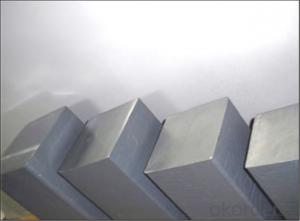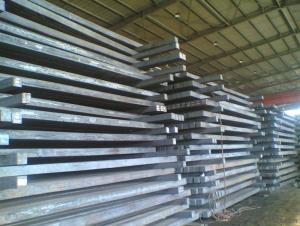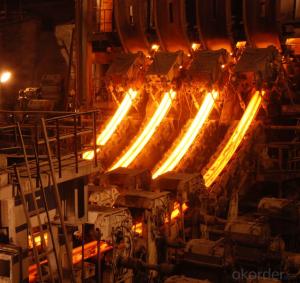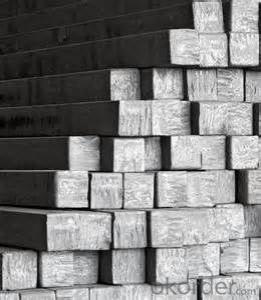Square Steel Billet Q235 3SP Grade Prime Quality 11#
- Loading Port:
- Tianjin
- Payment Terms:
- TT OR LC
- Min Order Qty:
- 2000 m.t
- Supply Capability:
- 50000 m.t/month
OKorder Service Pledge
OKorder Financial Service
You Might Also Like
Description of Square Steel Billet Q235 3SP Grade Prime Quality 11#
M. S. Billets are used for rolling of TMT Re-Bars of Fe415 and Fe500 Grade and various other structural steel products.
CRS Billets are used for rolling of CRS TMT Re-Bars.
Special Alloy Billets are used for rolling of any special grade TMT Re-Bars like Earthquake resistant TMT Re-Bars and for special grade structural steel products.
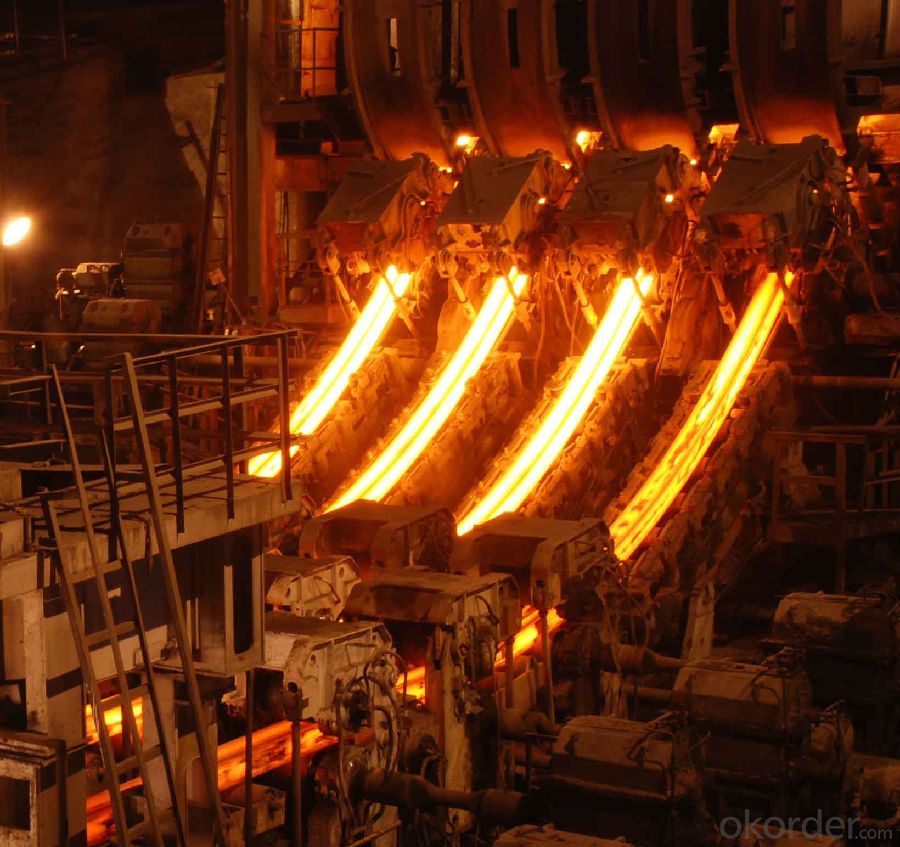
Main Feature Square Steel Billet Q235 3SP Grade Prime Quality 11#
Raw elements(C,Fe,Ni,Mn,Cr,Cu.)---Smelted ingots by AOD finery---hot rolled into black suface---pickling in acid liquid---cold drawn----polished by automatically machine--- cutting into pieces---checking quanlity
Applications of Square Steel Billet Q235 3SP Grade Prime Quality 11#
Widely Used in the areas such as Stainless Steel Fasteners, Chains, Kitchen and Sanitary wares, Furniture handles, Handrails, Electroplating and Electrolyzing pendants, Foods, Electron, Petroleum, Construction and Decoration, etc. Products have a high strength after cold-working. Electronic products parts, Medical appliance, Springs, Bus Inside and Outside packaging and building, Street Lamp Posts, etc. Decoration materials and Outdoor Publicity Billboard. Used for the products which have the Anti-Stress Corrosion requirement. Electron Products, Table-wares, Bolts, Nuts, Screen Meshes, Cumbustors and so on.
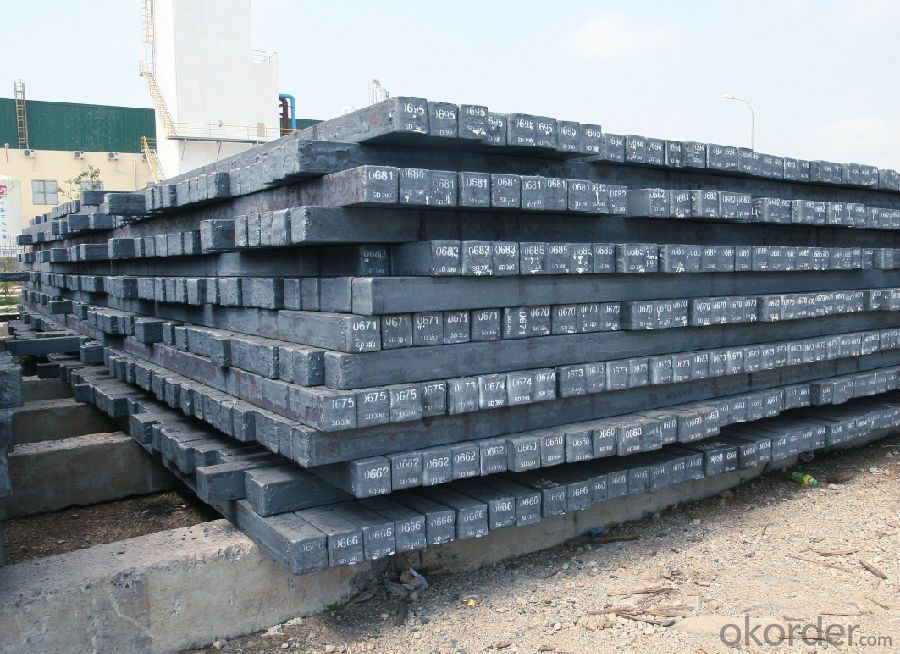
Specifications of Square Steel Billet Q235 3SP Grade Prime Quality 11#
| Standard | C(%) | Mn(%) | S(%) | P(%) | Si(%) |
| Q195 | ≤0.12 | ≤0.50 | ≤0.040 | ≤0.035 | ≤0.30 |
| Q235 | ≤0.20 | ≤1.40 | ≤0.045 | ≤0.045 | ≤0.35 |
| Q275 | ≤0.22 | ≤1.50 | ≤0.045 | ≤0.045 | ≤0.35 |
| 20MnSi | 0.17-0.25 | 1.2-1.6 | ≤ 0.050 | ≤ 0.050 | 0.40-0.80 |
| 3SP | 0.14-0.22 | 0.40-0.85 | ≤ 0.050 | ≤ 0.040 | 0.05-0.15 |
| 5SP | 0.28-0.37 | 0.50-1.00 | ≤ 0.050 | ≤ 0.040 | 0.15-0.30 |
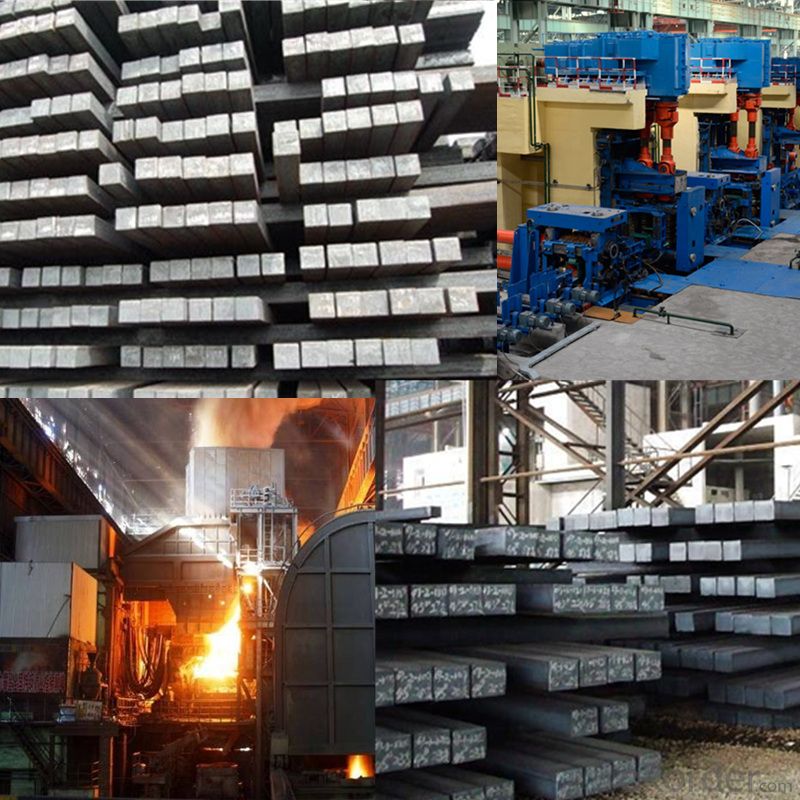
FAQ of Square Steel Billet Q235 3SP Grade Prime Quality 11#
We have organized several common questions for our clients,may help you sincerely:
1. How Can I Visit There?
Our company is located in Tianjin City, China, near Beijing. You can fly to Tianjin Airport Directly. All our clients, from home or aboard, are warmly welcome to visit us!
2. How Can I Get Some Sample?
We are honored to offer you sample.
3. Why choose CNBM?
Our delivery time about 15-20days for standard sizes, if you have other requirements like hardness, quanity and width ,it is about 20-40days. But don't worry we also try our best for the delivery time ,because time longer and our cost is higher.
- Q:What is the average density of a steel billet?
- The average density of a steel billet is typically around 7.8 grams per cubic centimeter.
- Q:How are steel billets used in the production of automotive suspension components?
- Steel billets are used in the production of automotive suspension components due to their strength, durability, and malleability. Billets are essentially semi-finished steel products that are formed into specific shapes, such as bars or rods, through a process called hot rolling. In the case of automotive suspension components, steel billets are first heated to a high temperature and then passed through a series of rollers to shape them into the desired form, such as coil springs, shock absorber rods, or stabilizer bars. The hot rolling process helps to refine the grain structure of the steel, resulting in improved mechanical properties. The use of steel billets in suspension components is crucial as they provide the necessary strength and stiffness to withstand the various forces and loads encountered during vehicle operation. Suspension components, such as coil springs, are responsible for supporting the weight of the vehicle and providing a comfortable ride by absorbing impacts and vibrations. Steel billets are preferred for automotive suspension components due to their high tensile strength, which allows them to withstand heavy loads and maintain their shape over long periods. Additionally, the malleability of steel allows for easy forming and shaping into various complex geometries, ensuring a precise fit and functionality within the suspension system. Moreover, steel billets offer excellent fatigue resistance, which is crucial for suspension components as they undergo repetitive loading and unloading throughout the vehicle's lifespan. This fatigue resistance helps to prevent failure and ensures a long-lasting and reliable suspension system. Overall, the use of steel billets in the production of automotive suspension components is essential for achieving the necessary strength, durability, and performance required for safe and comfortable vehicle operation.
- Q:What is the typical composition of a steel billet?
- The typical composition of a steel billet can vary depending on the specific grade and intended application. However, in general, a steel billet is primarily composed of iron, carbon, and other alloying elements. Iron is the main component of steel, typically making up around 98% of its composition. It provides the structural strength and durability of the material. Carbon is the second most important element, typically ranging from 0.02% to 2.1%. It plays a crucial role in determining the hardness and strength of the steel. Apart from iron and carbon, steel billets often contain various alloying elements to enhance specific properties. These alloying elements may include manganese, silicon, nickel, chromium, molybdenum, vanadium, and others. Each element contributes to different characteristics such as corrosion resistance, heat resistance, toughness, or machinability. Additionally, steel billets are often produced through processes like continuous casting or hot rolling, which can introduce small amounts of impurities. These impurities can include sulfur, phosphorus, and oxygen, which are typically kept to very low levels to maintain the desired quality of the steel. Overall, the typical composition of a steel billet encompasses a combination of iron, carbon, alloying elements, and minor impurities, which are carefully controlled to achieve the desired mechanical properties and performance for a wide range of applications, such as construction, automotive, aerospace, and manufacturing industries.
- Q:How are steel billets used in the manufacturing of machinery and equipment?
- Steel billets are an essential component in the manufacturing of machinery and equipment. These billets, which are semi-finished steel products, serve as the raw material that is further processed to create various components used in machinery. To begin with, steel billets are heated to a high temperature and then rolled or forged into different shapes, such as bars, rods, or tubes. These shapes are then machined and fabricated into specific parts and components required in machinery and equipment. For instance, steel billets can be transformed into gears, shafts, axles, pistons, and other crucial components that are used in engines, turbines, and other types of machinery. The use of steel billets in manufacturing machinery and equipment offers several advantages. Firstly, steel is known for its exceptional strength and durability, making it a suitable material for heavy-duty applications. Steel billets provide the necessary strength and rigidity required to withstand the demanding conditions and stresses that machinery and equipment often experience during operation. Secondly, steel billets can be easily molded and shaped according to specific design requirements. This flexibility allows manufacturers to produce complex and intricate components that are critical for the efficient functioning of machinery. The ability to customize the shape and size of steel billets enables the production of parts that fit seamlessly within the machinery, ensuring optimum performance and functionality. Moreover, steel billets possess excellent mechanical properties, including high tensile strength, hardness, and resistance to wear and corrosion. These properties not only enhance the longevity of machinery but also contribute to its overall performance and reliability. Steel billets are capable of withstanding harsh operating conditions and can endure significant loads and forces without deformation or failure. In conclusion, steel billets play a pivotal role in the manufacturing of machinery and equipment. Through various processing techniques, these billets are transformed into different components that are vital for the operation of machinery. The strength, flexibility, and durability offered by steel billets make them an ideal choice for the production of machinery that can withstand the demanding requirements of various industries.
- Q:How are steel billets inspected for chemical composition?
- Steel billets are inspected for chemical composition through a process called chemical analysis. This involves taking a sample from the billet and subjecting it to different testing methods to determine the precise amounts of various elements present in the steel. One common method used is spectrometry, specifically optical emission spectrometry (OES) or inductively coupled plasma (ICP) spectrometry. These techniques involve heating the steel sample until it reaches a plasma state, which allows the individual elements to emit characteristic wavelengths of light. By analyzing the emitted light, the concentration of each element can be determined. Another method is X-ray fluorescence (XRF) analysis. This technique involves bombarding the steel sample with high-energy X-rays, which causes the atoms in the sample to emit secondary X-rays. By measuring the energy and intensity of these secondary X-rays, the composition of the steel can be determined. In addition to these methods, other techniques such as mass spectrometry and wet chemical analysis may also be employed, depending on the specific requirements and accuracy needed for the inspection. Overall, steel billets are inspected for chemical composition using a combination of sophisticated analytical techniques, ensuring that the steel meets the desired specifications and quality standards.
- Q:What is the average weight of a steel billet?
- The average weight of a steel billet can vary depending on its size and dimensions. However, a typical steel billet can weigh anywhere between 1,000 kilograms (2,204 pounds) to 5,000 kilograms (11,023 pounds). These weights are typical for industrial-grade steel billets used in various manufacturing processes such as forging, rolling, and extrusion. It's important to note that the weight of a steel billet can also be customized based on specific requirements and industry standards.
- Q:Is the reaction of carbon and carbon dioxide a redox reaction?
- According to the increase or decrease of the oxidation number, the redox reaction can be split into 2.5 reactions: the half reaction of increasing oxidation number is called the oxidation reaction, and the reaction of reducing the oxidation number is called the reduction reaction.In the reaction, the oxidizing substance, called the reducing agent, forms the oxidation product. The reducing reaction substance is called the oxidant, and the reduced product is produced. The oxidation product is oxidized but weaker than the oxidant; the reducing product is reductive but weaker than the reducing agent.Whether a chemical reaction belongs to an oxidation-reduction reaction depends on whether the reaction has an increase in the number of oxidation, or whether there is an electronic gain or loss.Turn left and turn right |In this reaction, carbon dioxide carbon has a valence of +4 price, after the reaction of carbon monoxide in the carbon price is +2, the carbon dioxide is reduced to carbon monoxide; elemental carbon has a valence of 0 by the price to rise to +2 price, is oxidized to carbon monoxide; carbon is oxidized to carbon dioxide reduction.
- Q:How are steel billets cut into smaller pieces?
- Steel billets are typically cut into smaller pieces using a process called sawing or shearing. This involves using specialized machinery equipped with blades or shear tools to slice the billets into desired lengths or sizes.
- Q:How are steel billets used in the manufacturing of forgings?
- Steel billets are used in the manufacturing of forgings as they serve as the initial raw material. These billets are heated and then shaped using a variety of forging techniques such as hammering or pressing, resulting in the desired forged product. The high strength and malleability of steel make it an ideal material for forgings used in various industries, including automotive, aerospace, and construction.
- Q:Can steel billets be cold rolled?
- Steel billets cannot be cold rolled, as this process specifically involves reducing the thickness of a metal sheet or strip by passing it through a series of rollers at room temperature. Instead, steel billets are primarily utilized as raw material for producing steel bars, rods, and other long products through hot rolling. During hot rolling, the steel billets are heated to high temperatures and subsequently passed through rolling mills to achieve the desired shape and dimensions. Cold rolling is not appropriate for steel billets because it necessitates heating to enhance the steel's malleability and ability to deform, which cannot be achieved with solid, unheated billets.
1. Manufacturer Overview |
|
|---|---|
| Location | |
| Year Established | |
| Annual Output Value | |
| Main Markets | |
| Company Certifications | |
2. Manufacturer Certificates |
|
|---|---|
| a) Certification Name | |
| Range | |
| Reference | |
| Validity Period | |
3. Manufacturer Capability |
|
|---|---|
| a)Trade Capacity | |
| Nearest Port | |
| Export Percentage | |
| No.of Employees in Trade Department | |
| Language Spoken: | |
| b)Factory Information | |
| Factory Size: | |
| No. of Production Lines | |
| Contract Manufacturing | |
| Product Price Range | |
Send your message to us
Square Steel Billet Q235 3SP Grade Prime Quality 11#
- Loading Port:
- Tianjin
- Payment Terms:
- TT OR LC
- Min Order Qty:
- 2000 m.t
- Supply Capability:
- 50000 m.t/month
OKorder Service Pledge
OKorder Financial Service
Similar products
New products
Hot products
Related keywords
